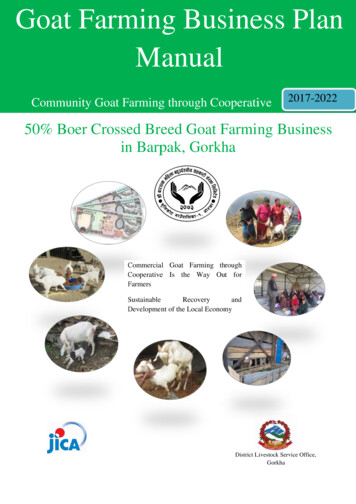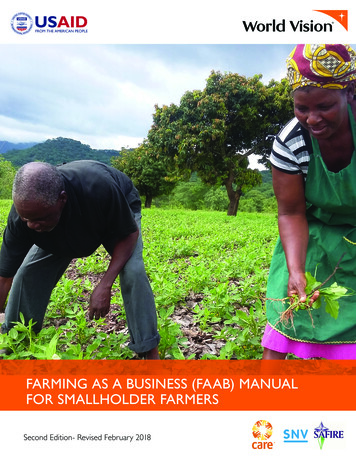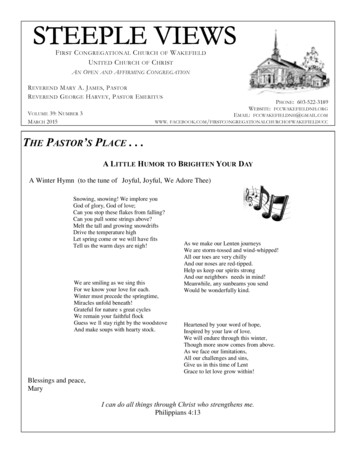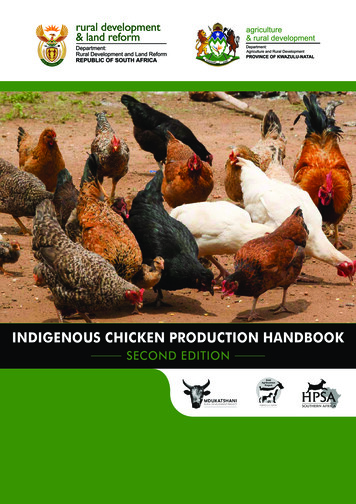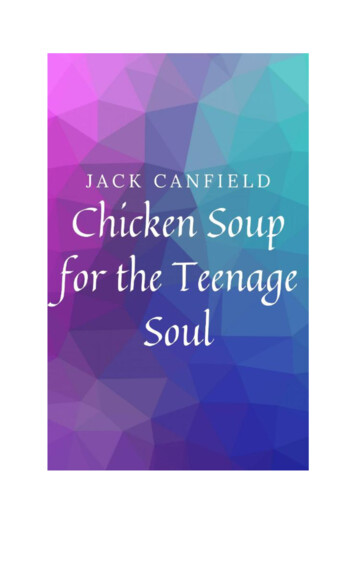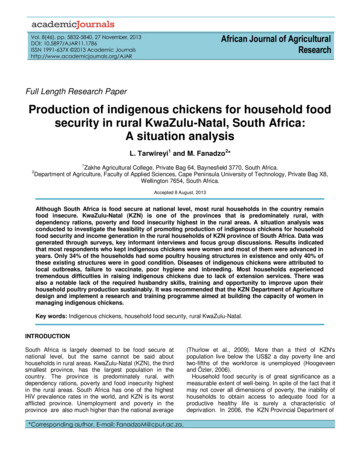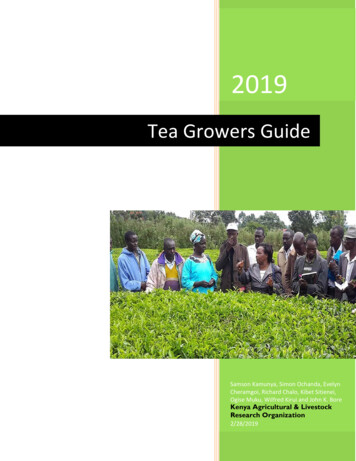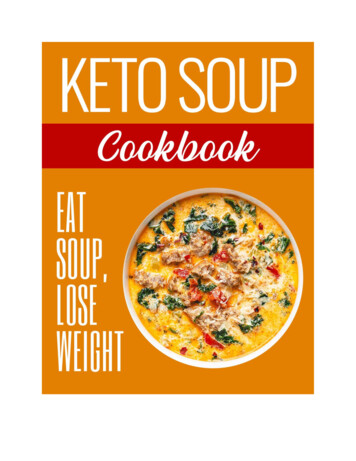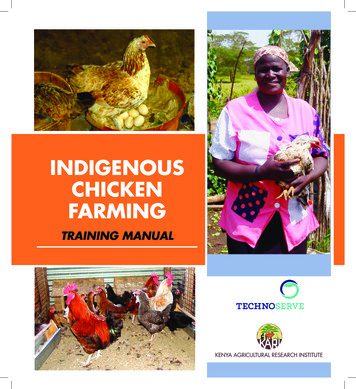
Transcription
INDIGENOUSCHICKENFARMINGTRAINING MANUALKENYA AGRICULTURAL RESEARCH INSTITUTE
Credits:Development of this publication was supported by the UnitedStates Department of Agriculture (USDA), and TechnoServeKenya. Its contents are solely the responsibility of the authors.Managing Editors: Dr. Ann Mumbi & Dr. Laurence OchiengPhotography & Illustrations by: Tony OkukuProduced by: Sketches Multimedia KenyaISBN : 978-9966-30-005-8
ContentsForeword1TOPIC 1. ROLE OF INDIGENOUS CHICKEN IN HOUSEHOLD ECONOMYIntroductionOwnership of Indigenous Chicken223TOPIC 2. GENDER AND INDIGENOUS CHICKEN FARMING4Topic 3. INDIGENOUS CHICKEN PRODUCTION SYSTEMSBasic Production Characteristics for Indigenous Chicken57Topic 4. Cost Benefit Analysis Of A Small Scale Indigenous Chicken Production System52 Weeks Plan88Topic 5. POULTRY DISEASE CONTROLWhat is Disease?Why Learn Disease Management and Control?Causes of DiseaseFactors Influencing the Health Status of Indigenous ChickenCategories of Common Poultry Diseases121212121315Topic 6. BIO-SECURITYCommon Bio-security Measures1617Topic 7. VACCINES AND VACCINATIONWhy Vaccinate?Vaccine SpecificityRules of VaccinationVaccine AdministrationPoultry Disease DiagnosisHistoryObservations of ChickenSeverity and Nature of the DiseaseManagement FactorsHow the Disease Might Have Entered the FlockClinical Examination of the Whole Fock and its EnvironmentExamination of the Whole FlockExamination of the EnvironmentExamination of a BirdPre-requisites for Brooding18181818192222222222232323232426Topic 8. CHICK PLACEMENT AND BROODINGWhy Brood?Preparations for Chick PlacementPreparation of a Brooder GuardChick CheckFeed ManagementLight ManagementBrooding Temperature2627272828282828
Chick BehaviuorInduction of ChicksTemperature Step DownChick Mortality29293030Topic 9. HOUSINGWhy Should Chicken be Housed?Site Selection for Poultry HousesMaterials for Building a Poultry HouseImportance of PerchesNestsChicken Runs31313232333435Topic 10. FEEDING INDIGENOUS CHICKENWhat to Feed?ScavengingTypes of FeedsSimple Feed MixingIngredient QuantitySimple Techniques for Growing Maggots and TermitesHow Much to Feed?How to Feed?Feed Mixing and FormulationCafeteria SystemCommon Feedstuff ProblemsFeeders and Drinkers36373738404041414242434343Topic 11. POULTRY SELECTION AND BREEDINGIntroductionChicken SelectionBreeds and SelectionBreedingDifferent Types of Chicken BreedsFeatures of Specialized BirdsCross-breedingCockerel Exchange Programs454545454748495050Topic 12. RECORD KEEPINGTypes of Record SheetsCommercialization515254Topic 13. MARKETING OF PRODUCTSIntroductionBirds for SaleEggs for SaleEconomic Analysis and Simple Risk Assessment5454555556Topic 14. CHICKEN 58
ForewordKenya has an estimated poultry population of 32 million birds, with indigenous chicken forming thelargest proportion of 75%, layers and broilers 24% while other poultry species make up 2 %. The industryis thus an important source of food, income, employment and has many social and cultural uses inaddition to having linkages with other sectors of the economy.Indigenous chicken offer a flexible production system, adaptable to many agro-ecological zones and areoften ranked highly as an existing resource whose productivity can be increased with minimal inputs.As such, they are highly suitable for vulnerable households and are often owned and managed by womenand children. Products from these chickens can improve nutrition security by providing high-qualityanimal protein (eggs and meat) at the household level. Commercializing the indigenous chicken sectorhas had several challenges among them frequent disease outbreaks, poor access to improved breedingstock, inadequate management skills, knowledge and information leading to poor productivity and lossof market opportunities.It is important for producers to learn and adopt good management practices that keep their chickenhealthy and productive. Training of service providers is thus an important part of a comprehensiveindigenous chicken improvement program. Good management practices and information should also beaccompanied by appropriate organizational and cost effective practices by all value chain stakeholders.This manual is a reference material for trainers and other service providers who embark on an indigenouschicken improvement program. The manual focuses on the use of good management practices for asuccessful indigenous chicken business.1
TOPIC 1.ROLE OF INDIGENOUS CHICKEN IN HOUSEHOLD ECONOMYIntroductionIndigenous chicken are the most abundant livestock in many rural and peri-urban householdsin Kenya. These chickens are also referred to as rural, village, backyard, scavenging, traditionalor family chickens, and have various names in local languages. They play an important role inhousehold economies in that they convert feed resources available in the homestead or householdinto highly nutritious and valuable protein products. Although their output in terms of weight gainand number of eggs per hen per year is low, it is obtained with minimal labour and other inputs.This factor of low input and, consequently, low risk is one of the major advantages of extensiveindigenous chicken production systems. Significant returns can be achieved from indigenouschicken without the need for expensive housing, complex technology and funding just by utilizinglocally available resources.Interventions aimed at improving productivity will consequently improve incomes and knowledgeof household members. Improvement programs should thus take advantage of the naturalcompetitive advantages inherent in indigenous chicken production systems.Animal protein consumed in rural areas frequently comes from indigenous chicken meat andeggs. Chicken can also be sold or bartered to meet family needs such as medicines, clothes andschool fees. In this way, they act as a ready source of cash for emergencies and small purchases.They also provide manure and play a role in pest control. These birds are also important duringspecial festivals, traditional ceremonies and treatments.Chicken meat and eggs provide a readily available, high-quality source of proteins, vitamins andmicronutrients. Eggs are an excellent source of iron, zinc and vitamin A, all of which are essentialto health, growth and wellbeing. Chicken and eggs contribute to a nutritious, balanced diet, whichis especially important for children, nursing mothers and many vulnerable groups.2
Ownership of Indigenous ChickenFig. 1: Feeding indigenous chicken in the homestead.Nearly all rural and peri-urban households keep small flocks of indigenous chicken,mostly owned and managed by women and children. Simple changes in management ofindigenous chickens can significantly improve production and the living conditions ofmany rural families in terms of enhanced nutrition and income generation through thesale of surplus chickens or eggs. Improved indigenous chicken production is thereforea low-cost and important aspect of enhancing food and nutritional security.3
Topic 2.GENDER AND INDIGENOUS CHICKEN FARMINGAnalysis of gender relations is of major importance for any type of intervention in rural areas,because the paradigms of access, control and benefits of resources and consequently of exclusionare based on the social relations between men and women.Therefore, the understanding of gender relations and their implications for livestock rearing areimportant in promoting appropriate interventions. Different members of the household can havedifferent, even contradictory, interests in agricultural production and livestock. The processesof decision making in households and communities are complex and dynamic. Although maleand female farmers have a lot in common, they often have different interests and problems. Menand women may have different interests in relation to animals they have access to and controlover. With the animals raised, each species plays a specific role and is owned and cared for bydifferent individuals in the household.When commencing an interventionto support indigenous chickenproduction, it is advisable to workwith both male and female farmersto determine:1. Level of chicken production in the area?2. Major constraints and opportunities forincreased productivity3. The most efficient way to promote theselected intervention?These issues have to be considered inthe interest of establishing successfulcollaboration and dialogue with male andfemale farmers.Fig 2: Gender roles in indigenous chickenbreeding management.4
Topic 3.INDIGENOUS CHICKEN PRODUCTION SYSTEMSIndigenous chicken production systems maybe divided into three different categoriesbased on management practices;A: Traditional free-range;B: Improved semi-free-range andC: Small-scale confined systemi) Free range systemii) Improved semi-free range systemiii) Small scale confined systemFig. 3: Indigenous chicken production systems5
Table 1: Indigenous Chicken Production SystemsCriteriaA: Traditional free rangeB: Improved semi-free rangeC: Small scale confined1-10 birds5-50 birds or aboveMore than 100LowMediumHighOwnershipMostly owned by womenOwned by women and familyBusinessmen and womenPurposeFor home consumptionHome consumption /incomegenerationIncome generationSocial RoleSocial & culturalimportanceSocial importanceNo social provedHigh mortalityModerate mortalityLow mortalityScavengingScavenging SupplementationCommercial feedsNo vaccinationNCD vaccination andoccasionally Fowl poxVarious vaccinationschemesShared with otherhousehold members atnightSimple housing made of localmaterial with a runHousing made of conventionalmaterialAnnual NoGrowth e (Based on need)High (Must have readilyavailable market)LabourMinimalAverageIntensiveFlock sizeInputsMortalityFeed SourceDisease controlHousing6
Basic production characteristics for indigenous chicken:1. Hens will start laying when aged 24 - 30 weeks’ old2. At any given time, only about half the hens are productive and some 8 - 10% are out of lay.3. Egg weight averages 40 g (range 35 - 65 g).4. Most birds produce 2 - 4 clutches per year, although some birds may produce 5 - 6 clutches. Thereare about 10 eggs per clutch, with a range of between 5 and 20.5. About 70 - 90% of the eggs will hatch (depending on management practices). Only 20 - 50% of chickshatched will reach productive age. Approximately 85% of these losses occur in the first 3 weeks oflife. Adult mortality is very variable and depends on specific local conditions and the occurrence ofdiseases.6. Both sexes have a body weight of about 1.2 kg at 10 - 12 weeks (although males are slightly heavier).Adult hens weigh between 1.0 and 1.5 kg, while roosters weigh between 1.3 and 2.5 kg.Chicken lays eggs21 days5 month periodMarketFig. 4: The life cycle of an indigenous hen7
Topic 4.Cost benefit analysis of a small scale indigenouschicken production system52 weeks planIn the example referred to in Table 2 (below), the flock size is initially 5 hens and 1 cock, allindigenous chicken. A production may also start with less, i.e. only 1 hen laying eggs, fertilizedby a free range cock from a neighborhood. Figures will then have to be adjusted accordingly. With1 cock and 5 hens, of which no more than 3 hens at any given time are allowed to go broody, theflock size may grow to a maximum of 24 growers and 6 adults which is manageable for a freerange poultry enterprise. Under a free range system the scavenging feed resources on the farmwill be less depleted if the flock size is kept small (below 6 - 10 adults and 20 - 30 growers andchicks).1.3.3 hens sitting on eggs, 1 cock roaming with 2 hensVaccinating chicken through an eye drop.2.3 hens each with 8 chicks walking and feeding4.Fig. 5: Production Plan8Selling of chicken (hens and cockerels)
Table 2: Input and output of a free range indigenous chicken enterpriseFlock sizeNumbersHens laying and brooding3Hens laying and not broody2Cocks1Surviving chicks/hen/batch*8Growers. Weeks 4-2424Total flock size30Feed consumption:Assumption(1 kg/bird/4 weeks 35 g/bird/day)KgAdult feed: 1 kg x 6 birds x 52 /4 weeks78Chicks/growers feed: 1 kg x 24 birds x 46/4 weeksEgg production276NumbersBroody hens. 72 eggs/bird/year216Hens not going broody. 104 eggs/bird/year208Eggs for hatching. 3 hens x 12 eggs x two batches/year-72Home consumption:1.5 egg/week-82Saleable birds: 3 batches x 8 growersNumbersCockerels. 22 weeks of age24Pullets for sale. 24 weeks of age24*(12 eggs laid 10 eggs hatched 8 chicks surviving after 4 months)Supplementary feeding should also be low to reduce costs. However, chicks aged a day old-to-8 weeksshould be supplemented. On average each bird will be given 2 kg feed for 8 weeks. This corresponds to2,000 g/56 days. Chicks will eat or feed on less while older birds will eat more. 2 batches of 24 growerswill require feed two times 22 - 24 weeks, i.e. 44 - 48 weeks, on average 46 weeks. The total annual needfor feed in a flock of 6 adults and 24 chicks and growers is calculated below.Supplementary feed needed for a flock of 30 birds in one year.1 cock: 1 x 1 kg/ 4 weeks x 52 weeks 13 kg5 hens: 5 x 1 kg/ 4 weeks x 52 weeks 65 kg24 chicks/growers: 24 x 1 kg/ 4 weeks x 46 weeks 276 kgTotal: 354 kg9
Improved management and feeding increases egg production of the non-broody hens to 104 eggs perhen per year, i.e. 2 eggs per week on average.Broody hens will also on average lay 2 eggs per week,excluding 2 x 3 weeks hatching (sitting on eggs) 2 x 5 weeks brooding, i.e.2 x 8 weeks 16 weeks non-laying period per year.Annually each hen will then lay;52 - 16 weeks 36 weeks x 2 eggs 72 eggs/hen/year.For three hens going broody only twice a year, the total egg production will be3 x 72 216 eggs/year.A production of 24 cockerels and 24 pullets per year (Table 2 and 3) is based on the following assumptions:1. The sex ratio of hatched chicks is assumed to be 50:50.2. A well-managed broody hen will sit on 12 eggs and hatch on average 10 chicks (about 80% hatchability).3. Using the basket system (housing) and improved management, chick mortality will reduce to a maximumof 1 chick out of ten during the first 4 weeks (equal to 10%) and 1 grower out of nine in the remaining 20weeks.4. At the age of 22-24 weeks, when the growers are sold, on average 8 growers per batch will be alive.5. Using three broody hens, a total of 3 x 8 growers 24 birds may be sold twice a year.A well-managed production plan means selling birds at the time of highest price, and buying feeds, newhens or inputs (e.g.feeders and drinkers) at the time of the lowest price. For many farmers this meanskeeping the birds in the flock until the festive season (e.g. IDD, Christmas, Easter or national holidays),where they may get a price often two or three times the normal price. However, it is important to stressthat keeping birds in the flock means more feed and a higher risk in terms of loosing birds throughpredators, diseases or theft. In general birds should be sold no later than at the age of maturity, e.g. 22- 32 weeks of age.In the example, in Table 2 and 3, the cost of feeding one bird was KES. 110.50 every 4 weeks, as onekg feed costing KES.15 would be spent during 4 weeks. In this case, if you want to keep a chicken for4 weeks longer in the flock, you should be sure to gain more than KES. 110.50, from the market price.Otherwise, it would be better to sell 4 weeks earlier at a lower price, and thus be able to restock withnew growers. Thus, by knowing the market and environmental conditions and by doing simple economiccalculations, you will be able to plan when you should sell your birds, when you should let your hens gobroody, and when you should keep your birds in the flock.10
Table 3: Cost-benefit analysisCost benefit analysisDescriptionCost5 hens and 1 cockUnit costCash flowKES.KES.(5 x 300) (1 x 400)1,900Basket, night day baskets2 baskets6001,200Low cost home – made feed354 kg155,31060 doses/year3180Vaccine medicineMiscellaneousCash out – flow8,590Income (Benefit)Sale of eggs424-154 270102,700Sale of cockerels, 22 weeks (Cockerelsgrow faster than pullets)244009,600Sale of pullets, 24 weeks243007,200Total cash in flow19,500Net Cash Flow10,91011
Topic 5.POULTRY DISEASE CONTROLWhat is disease?Disease can be defined as any change or impairment of normal body function that affects the chickens’ability to survive, grow or reproduce.An understanding of the cause of a disease and its method of spread (transmission) will assist incontrolling it. Knowledge of the clinical signs of a disease and the characteristics of lesions found at Postmortem will help in its diagnosis and instituting preventative measures.Why Learn Disease Management and Control? Diseases kill Interfere with normal growth Reduce productivity (eggs/ meat) Diseases lead to heavy losses Affects local and international tradeCauses of DiseaseMany diseases – called infectious diseases – are caused by organisms that can be transmitted fromone bird to another. Such organisms include viruses, bacteria, fungi and protozoans. Other infectiousorganisms are external (lice, fleas and ticks) or internal (roundworms, tapeworms, flukes) parasites.In many cases, disease results from a combination of factors such as husbandry, nutrition, environmentalfactors and flock management. All these have a direct and important influence on the health andproductivity of chickens.12
Factors Influencing the Health Status of Indigenous ChickenGeneral conditionAgeStressInherited characteristicsSusceptibility to diseaseChickenClimate (temperature,rain, wind)Housing conditionsAvailablity of waterAvailability of feedFeed QualityAir QualityEnvironmentInfectious AgentsVirusesBacteriaMycoplasmasFungiParasitesFig. 6: Factors influencing the health status of indigenous chicken.Characteristics of Healthy Birds Alert and on guard Bright eyes and comb Walk, run, stand and scratch Continuously eat and drink Normally lay eggs Normally smooth and neat feathers Soft compact droppings Breathe quietlyFig.7: Healthy chicken13
Characteristics of Unhealthy birds Tired and lifeless Dull eyes and comb Sit or lie down Eat and drink less Diarrhea Lay less or stop laying eggs Ruffled and loose feathers Wet droppings with blood or worms Cough, sneeze and breathe noisily.DroopyCosts Associated with Disease Mortality Morbidity Reduced productivity- weight gain/egg production Downgrading at processing Treatment Vaccination Surveillance and monitoring Loss of market Public health control Welfare perceptions Fowl TyphoidNote: Preventing disease is better and generally cheaperthan treatment. Preventing diseases in indigenous chickenby use of vaccination and improved management is themost cost-effective approach for disease control.Twisted neckDiarrheaTired & lifelessFig. 8: Sick chicken14
Categories of Common Poultry DiseasesDiseases in poultry are divided into three categories and the importance of a disease is judged by itsmortality rate and effect on production;a)Diseases of High importance:These are diseases with high mortality (more than 30% of the flock), highly contagious and difficult totreat. They include diseases such as; Newcastle Disease Avian Influenza (AI) Fowl pox Fowl cholera (pasteurellosis) Coccidiosis (internal parasites)b)Diseases of Medium importanceThese are diseases with medium mortality (10 - 30% of the flock) and/or difficult to treat. They includediseases such as; Pullorum disease (Baciillary white diarrhoea) Gumboro (Infectious Bursal Disease, IBD) Infectious coryza Chronic respiratory disease (Mycoplasmosis) Roundworms and tapeworms (Internal parasites Mycotoxicosis (fungal poisoning) External Parasitesc)Diseases of less importance:Not common, with lower mortality and/or easy treatment. Marek’s disease E. coli infection Scaly legs Nutritional diseases15
Topic 6.BIO-SECURITYBiosecurity is a set of management practices whichwhen followed, collectively reduce the likehood ofintroducing or spreading disease causing organismsonto and between sites.Most infectious agents enter the chicken via the beakwhile eating, drinking or cleaning its feathers, orduring breathing. Other infectious agents can infect awounded chicken. The agent then multiplies within thechicken and may spread, causing damage to certainorgans result into clinical signs. After multiplication,some of the infectious agents leave the chicken throughdroppings, in discharges from lesions, in its breath, oreven on dropped feathers. When other chicken comeinto contact with these contaminated items, then theytoo may get infected.Infectious agents can survive outside the chicken forvariable periods. Worm eggs and coccidia, for example,can survive for several months in the environmentwhile some other infectious agents are easily destroyedby sunlight, disinfectant or heat.In the spread of diseases caused by agents that areeasily destroyed, a direct contact between the chickenand agents is necessary. Infectious agents that cansurvive for a certain period in the environment canalso be spread via persons, animals and materials thatmight carry the agent. The infectious agent might becarried with small traces of droppings on shoes, orin the dust or small feathers attached to any roughsurface, on the eggshell or any part of a dead chicken.Fig. 9: A fenced poultry unit with restricted entryand a pedestrian foot bath at the entrance.NOTE: Some infectious poultry diseases forexample Newcastle disease cannot be controlledby good production and flock management alone.Such diseases are caused by contagious virusesand can lead to high losses in chicken or otherpoultry species. Because of their huge impacton the poultry industry, they are referred to asnotifiable diseases. Outbreaks must be reportedto, and control measures coordinated by, theveterinary departments.Once infectious agent enter the chicken, the chicken does not get sick immediately. It usually takes some daysfor the bird to show signs of illness. This period is reffered to as the ‘incubation period’. During this period thebird does not show any signs of disease but the number of infectious organisms inside it increases rapidly andsome organisms may leave the bird when it breathes or drinks or passes droppings. This means that the agentscausing an infectious disease can be spreading even before clinical signs of the disease are manifested.Some infectious diseases can also be spread vertically, i.e. from the hen to its offspring, via the eggs. To date,vertically transmitted diseases are more of a problem in commercial poultry enterprises.16
VehiclesPeople, birds and otheranimalsEnvironmentSick and dead chickenFeedsEggsFig.10: How diseases are spreadCommon Bio-security Measures Location: Avoid locations close to existingpremises (between farms 500m-1 km); Useprevailing wind directions when planning tominimize risk of airborne infection All-in-all-out: Reduce build up of diseasecausing organisms by breaking the rearingcycle for different ages. Litter disposal: Remove used litter andproperly dispose and disinfect it. Site security: Reduces possible introductionof infection to premises mainly from personnelmoving between houses and flocks, equipmentsand other innate objects.Fig. 11: Bio- security measures;Disposing dead birds through burying and burning.17
Topic 7.VACCINES AND VACCINATIONVaccines protect chicken from infectious diseases but they cannot treat diseases. Moreover, vaccines aredisease-specific and protect chicken against a specific disease rather than all diseases. Vaccines workbest on healthy, well-managed chicken.Why Vaccinate?1. Because many infectious disease agents are alwayspresent in the environment and are difficult to controleven with the best bio-security measures2. To reduce losses due to morbidity and mortality causedby infectious agents3. To protect chicken against diseases causing eggproduction drop and egg shell deformitiesVaccine SpecificityA particular vaccine will protect chicken against a specific disease. Chicken may suffer from otherdiseases despite successful vaccination. VACCINATION can NEVER provide 100% protection; but it ispart of a complex preventative policy of which biosecurity and hygiene are equally essential.Rules of Vaccination1. Vaccination should not to be administered to sick birds2. Always adhere to the genetic make-up of the chicken3. Cost the benefits of vaccination against potential loss4. Maternal antibody status - often have a significant effect on the design of a vaccination programme.18
Vaccine AdministrationVaccines should be stored at 4 - 8oC andprotected from heat and direct sunlight.Vaccines should be transported in a coolbox.All equipments used for vaccination should bedisinfected in boiling water.NOTE: Vaccination programmes are NOT universaland have to be designed based on: Type of chicken Production systems Disease prevalence in the local areaDO NOT USE CHEMICALS to disinfect vaccinationequipment. Instruction on vaccine dilutions should befollowed as per the manufacturer’s instructionsSome vaccination methods are shown below:i) Eye dropsiii) Skin piercing (wing web)ii) Injections (breast/thigh/neck muscle)iv) Orally (in feed or water)Fig. 12. Some vaccination methods19
NOTE: It is best to vaccinate birds during the cool hours of the day, either in themorning or evening. Vaccines should be used within 60 minutes after reconstitution.Always consult a veterinarian when in doubt before vaccinationVaccination tools include Vaccines, Distilled water, Sterile needles, syringes, Cool box and a cleanapron and gumboots.Table 4: Common Poultry diseasesDiseaseCausative AgentViralVirus can survivein dead host orexcretions up to12 months;NewcastleVirus is sensitiveto disinfectants,fumigants andsunlight.GumboroViralAges severelyaffected 14 -28days;signs commonestat 4-6 weeks oflife. Virus resistantin houses anddroppings.TransmissionCommon SignsCoughing, nasaldischarge, gasping,Drooping wings,Aerosols, Ingestion, Paralysis TwistingContact (Human,of head and neckdead birds,Swelling of headdroppings, eggsGreenish/waterycontaminateddiarrhoea Highshells)mortalityPM-Petechiae inproventiculus, gizzardand enteritisOral,Respiratory tractVent pecking,Diarrhoea with uratein mucus, Suddendeath, PM-Skeletalbleeding, SwollenBursa of Fabricious,Dehydration, Swollenkidneys with urates.Effects to Birds Death in highnumbers Drop in eggproduction Blood spots ineggs Rough/ shell-lessegg Reducedhatchability Moderate deaths SecondaryinfectionsManagement &Control Quarantines Institute biosecuritymeasures All in-all out Vaccination Vaccination asscheduledCutaneous form:Nodular lesions ornon-feathered skinFowl pox20ViralContact Retarded growth Decreased eggDiphtheritic form:productionLesions on mucus Low or moderatemembranes of mouth,mortalitiesoesophagus, pharynxand trachea Vaccination andQuarantine
InfectiousCoryzaFowl TyphoidIncubation period of1-3 days, fast spreadBacteriaof disease to the whole Loss of conditionSurvives for 2-3flock Drop in eggdays outside theFacialswellingConjuctiva or nasalproductionbird but is easilyPurulent ocular and Low mortalitykilled by heat,dryingnasal dischargeand disinfectant.Sneezing anddyspnoeaBacteriaContactIn chicks- acuteinfections withsudden deaths of upto 90%Vent pasting withchalky-white excretaCoccidosisCoccidiaA protozoan withseveral speciesParasites multiplyintracellularly,infection common inover-stocked flocksOocysts remainviable for manymonths but killedby freezing, extremedryness and hightemperaturesBloody stainedIngestion ofdroppings or yellowishcontaminated feed diarrhoeawith bird droppingscontaining oocysts High mortality aroundthe 6-8th week of lifeSeveral wormsInternalparasitesExternalparasitesInfestation with e.gIngestion ofRound worms,infective stage ofAscarides, Cestodes, wormsTapewormsMites, Fleas, Liceand TicksContact High death up to90% Poor growth, Poor feathering ofsurvivors Decreases eggproduction Antibiotic andVaccination Impaired feedutilization orconversion Uneven growth High death rates Low production Outbreaks treatedimmediately usingcoccidiostats Avoid contaminationof feeds and waterby droppings Avoid wet-litter Avoid over-crowding Coccidiostats mixedin feeds for youngflocks Downgrading ofeggs - Loss of shellcolour, strength,yolk colour andegg sizeLoss of body condition Poor weightDeath in heavygain, poor feedinfestationsconversion Increasedcannibalism viavent pecking dueto strainingUncomfortableScratching, pecking,irritation, blood loss,loss of feathers Antibiotic;Flouroquinolones,might preventcarriers. Keep Coryza-freebirds Proper managementof the flock. Use appropriatedewormers e.g.Fenbendazole,Piperazine orLevamisole Strict sanitation Segregate birds byage group Clean house beforeintroduction of newbatch Use appropriate Retarded growthacaricides Reduced egge.g. SyntheticproductionPyrethroid, Damaged plumageOrganophosphates Death Ensure stricthygiene21
Poultry Disease DiagnosisHistoryThe case history will give information aboutthe course of disease (number of birds affected,severity and duration of the disease), the meansof introduction into the flock and whether or notthe disease is infectious. The person lookingafter the chicken should be asked the followingquestions since they generally have a betterunderstanding of what is going on in the flock.Observations of chicken:a) Why do you think the chickens aresick?b) Describe the signs observed.c) What age groups are affected by thedisease (chicks, growers, adults)?d) When did your chicken become sick?Fig. 13: A farmer observing her chicken.Severity and nature of the disease:a) How many chicken do you have?b) How many of them are sick?c) Have any of your chicken died? OR Have any chicken been disposed recently becaus
flock size may grow to a maximum of 24 growers and 6 adults which is manageable for a free range poultry enterprise. Under a free range system the scavenging feed resources on the farm will be less depleted if the flock size is kept small (below 6 - 10 adults and 20 - 30 growers and ch
